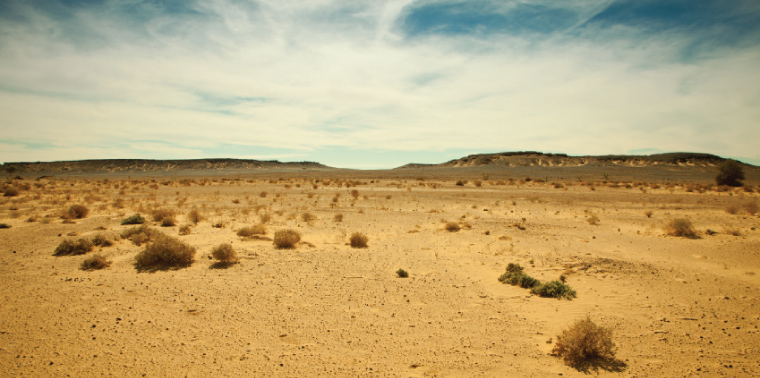May 6, 2013 — The Sahara is probably the most iconic desert on Earth, evoking visions of desiccated landscapes dominated by scraggly shrubs and naked soil.
But it wasn’t always that way. Just 6,000 years ago, the Sahara was lushly vegetated and nourished by frequent rainfall. Within the course of a few centuries (or a few decades, depending on the study), everything changed. The rains dried up, plants withered and the modern Sahara emerged.
For most of the 20th century, scientists had no idea how to explain this. Evidence of a radical shift — provided by fossils, sediment deposits and abandoned villages — was overwhelming. According to standard ecological theory, however, such a massive change shouldn’t have happened so quickly. The most popular explanation was that slow and subtle shifts in Earth’s orbit changed solar radiation levels, causing a drop in rainfall patterns. But computer simulations of the shift failed to replicate the speed at which this had taken place.
Meanwhile, researchers were baffled by a more contemporary puzzle in the Sahel, a band of arid grasslands that cross Africa beneath the Sahara. Starting in 1969, the Sahel experienced a devastating drought. Whereas most other droughts around the world last for just a few months, this one has lasted for three decades, repeatedly reaching new lows in rainfall.
Ecosystems can exist in “alternative stable states,” with only a nudge needed to flip them from one to the other.
In the past, many scientists attributed this to changing sea surface temperatures and tropical circulation patterns. But changing temperatures alone couldn’t account for the drought’s unprecedented severity and duration.
It was only when ecologists developed new models describing interlocking relationships among land, vegetation, atmosphere and oceans that things started to make sense. Suddenly they could reproduce the Sahara’s rapid desertification and the Sahel’s record dry spell.
Out of this work — along with research on polluted ponds and damaged coral reefs — came a new theory of ecosystem change: Transition doesn’t need to be linear and gradual. Rather, it can take place rapidly and unpredictably. Ecosystems can exist in “alternative stable states,” with only a nudge needed to flip them from one to the other.
Today, scientists believe these so-called critical transitions can take place in many different ecosystems. But even if they happened only in arid and semi-arid lands, there would be plenty of reason to pay attention. Such lands cover some 40 percent of the world’s surface and support a billion people. As ever more water is diverted to grow crops and more animals are put out to pasture, the nudges are many and strong. And greenhouse gas pollution and climate change are only adding to the pressure.
“We don’t know where the thresholds are,” says Marten Scheffer, an ecologist at the Netherlands’ Wageningen University. “But we know they’re there and that we cross them.”
From Theory to Practice
Today, scientists are trying to figure out how to handle these critical transitions. One approach acknowledges the possibility of thresholds to guide land management strategies. If strategies needed to be calculated from scratch for each region, the task might be impossible. But a set of generic models, called typologies, might sketch the parameters of any arid system.
“We try to get lots of data from where thresholds have clearly been crossed, and understand where the threshold and the system were when that happened,” says Brian Walker, an ecologist at Australia’s Commonwealth Scientific and Industrial Research Organization. “Then you can say, ‘I’m in a semi-arid rangeland in Africa, and this is what I should be watching out for.’”
Many of the world’s semi-arid rangelands behave in much the same way, with their states determined by feedback loops among water, vegetation, soil and climate.
The findings of Walker and his colleagues are now used to guide grazing and fire prevention patterns at test sites in South Africa and Southeast Australia. Although those tests may prove successful, applying the approach elsewhere may prove tricky.
“When you get to the field, you have to deal with particular ecological patterns. You have to deal with the technology and methodology that’s available for collecting data. You have to deal with the reality of sampling, and figure out how you’re going to use those samples and analyze them,” explains Craig Allen, a research ecologist with the U.S. Geological Survey who’s studied transitions in the American Southwest.
In addition to typologies, scientists need early warning signs: something to tell them if their plans aren’t working or if a system is in danger of tipping. Theoretically, this is possible. According to models and real-world testing, a system that’s approaching a critical transition should lose its equilibrium in mathematically verifiable ways.
Ensia shares solutions-focused stories free of charge through our online magazine and partner media. That means audiences around the world have ready access to stories that can — and do — help them shape a better future. If you value our work, please show your support today.
Yes, I'll support Ensia!
